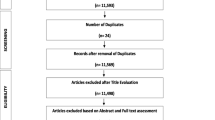Abstract
Data sources Sources were Medline, the Cochrane Library, reference lists of identified articles and selected textbooks.
Study selection Selected studies were randomised clinical trials (RCT), quasi-RCT or controlled clinical trials that compared fissure sealing with no treatment or another preventive treatment, in children of up to 14 years of age at the beginning of study, with clearly described diagnostic criteria, and with at least 2 years follow-up. Studies reported in Danish, English, French, German, Italian, Norwegian, Spanish or Swedish were considered.
Data extraction and synthesis Inclusion decisions and grading of the studies was done independently by two of the authors. The main outcome was caries increment and the measure of treatment effect was either relative risk (RR) reduction or prevented faction. A pooled estimate was calculated for studies using resin-based materials.
Results Thirteen studies were included, eight of which used resin-based material and were selected for meta-analysis. The pooled estimate of effect for a single application of resin-based sealant on first permanent molars showed the RR of developing caries in sealed teeth relative to controls was 0.67 (95% confidence interval, 0.55–0.83), a reduction in RR of 33%. For repeated applications, the reduction in RR varied from 69 to 93%.
Conclusions The review provides limited evidence that fissure sealing of first permanent molars with resin-based materials has a caries-preventive effect. The evidence is incomplete for second permanent molars, premolars and primary molars and for glass ionomer cements. Overall, there remains a need for further trials of high quality, particularly in child populations of both low and high caries risk.
Similar content being viewed by others
Commentary
The development of adhesive technologies in dentistry has allowed the development of a series of clinical procedures for the primary prevention of dental decay. This has allowed the preservation of dental tissues and has promoted a minimally invasive approach for the treatment of dental caries, even in early non-cavitated stages. Dental sealants have been used for the last 30 years. Currently they are available in photo- or chemical-cured forms, resin or glass-ionomer based, or with or without fluoride. Some guidelines and protocols recommend the use of resin-based sealants in high-caries-risk children.
This systematic review is part of a series realised for the Swedish Council on Technology Assessment in Health Care (SBU) on different methods of caries prevention. This one focuses on the effectiveness of fissure sealant for the prevention of occlusal caries in different teeth.
The main findings of the review are that there is currently limited evidence to support the use of resin-based sealant, and the preventive effect ranges between a reduction in RR of 33% for a single application and 69–93% for repeated applications.
From the research and clinical point of view, there are three main points on note in this review.
-
Despite the large number of articles about the performance of sealants for the prevention of caries, only 13 meet all the inclusion criteria, and none of them can be considered high-quality evidence.
-
The most often-cited studies, considered as landmark publications in preventive dentistry research, do not meet the minimal requirements for they inclusion.
-
The majority of the studies included were from the 1970 s, in fact eight of 13, and only three of the 13 were published during the last decade.
The fact that the majority of the included studies are from the 1970 s raises an number of questions. Was the research of that decade better than the current research? Or was less published but of better quality? On the other hand, from a clinical perspective, does the baseline caries prevalence affect the effectiveness and cost–benefit ratio of sealants? How valid are recommendations made for materials that are no longer in the market? What is the effectiveness of the current materials? The fact that the majority of the studies came from that decade agrees with the Cochrane systematic review of dental sealants,1 as do the authors recommendations of the need for well-designed clinical trials that include cost–benefit analysis taking into consideration the actual prevalence of caries. There is also a need to answer which groups receive the greatest benefits from this intervention.
In the website of the SBU the method given for the review involves only Medline searches, but in the published paper the authors also consider the Cochrane Library. Even though the search included various languages, only articles in English and Swedish were cited. There is potential for bias here as in some non-English databases such as SCIELO (www.scielo.org) it is possible to find relevant.papers2 Maybe future systematic reviews need to explore not only standard databases such as Medline but also find more representative databases from different continents.
It is notable that the majority of the most-often cited studies were excluded from the analysis. Does this mean that the traditional statement that a sealant is effective as long as it remains attached to the tooth is no longer valid? The answer from this well-designed systematic review is that the evidence supporting this theory in not as solid as we thought. We need more high-quality clinical trials, although the sealants are still recommended for the prevention of caries in permanent first molars.
Practice point
-
Resin-based sealants have a a caries-preventive effect but more high-quality clinical trials are needed.
References
Ahovuo-Saloranta A, Hiiri A, Nordblad A, Worthington H, Mäkelä M . Pit and fissure sealants for preventing dental decay in the permanent teeth of children and adolescents (Cochrane Review). In the Cochrane Library. Chichester: John Wiley; 2004; Issue 3.
Prados Atienza MB, Bravo Perez M, Munoz Soto E, et al. Effectiveness of fissure sealant and fluoride varnish on different tooth surfaces: A 24-month field trial. RCOE [online]. Mar.–Apr. 2002; 7:67–174 [cited 02 November 2004]. Available from World Wide Web: http://scielo.isciii.es/scielo.php?script=sci_arttext&pid=S1138-123X2002000300003&lng=en&nrm=isoISSN1138-123X.
Author information
Authors and Affiliations
Additional information
Address for correspondence: Ingegerd Mejare, Department of Paediatric Dentistry, Eastman Dental Institute, Stockholm, Sweden. E-mail: ingegerd.mejare@ftv.sll.se
Mejare I, Lingstrom P, Petersson LG, Holm AK, Twetman S, Kallestal C, et al. Caries-preventive effect of fissure sealants: a systematic review. Acta Odontol Scand 2003; 61:321–330
Rights and permissions
About this article
Cite this article
Uribe, S. The effectiveness of fissure sealants. Evid Based Dent 5, 92 (2004). https://doi.org/10.1038/sj.ebd.6400291
Published:
Issue Date:
DOI: https://doi.org/10.1038/sj.ebd.6400291



